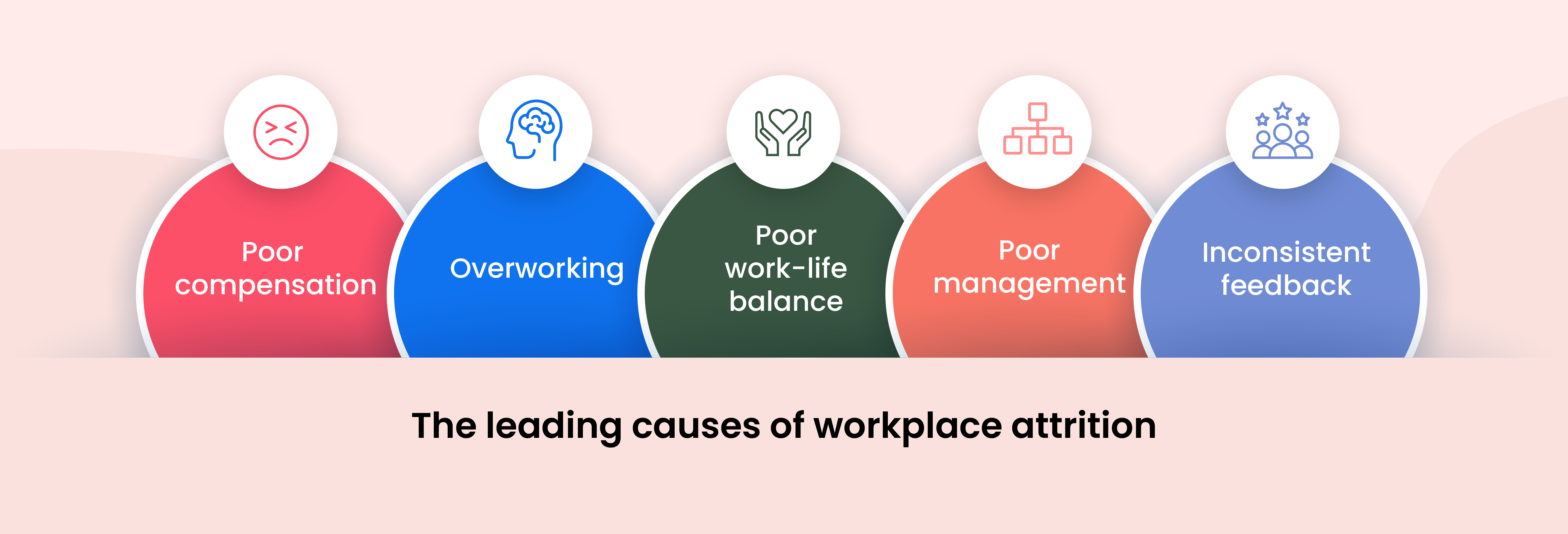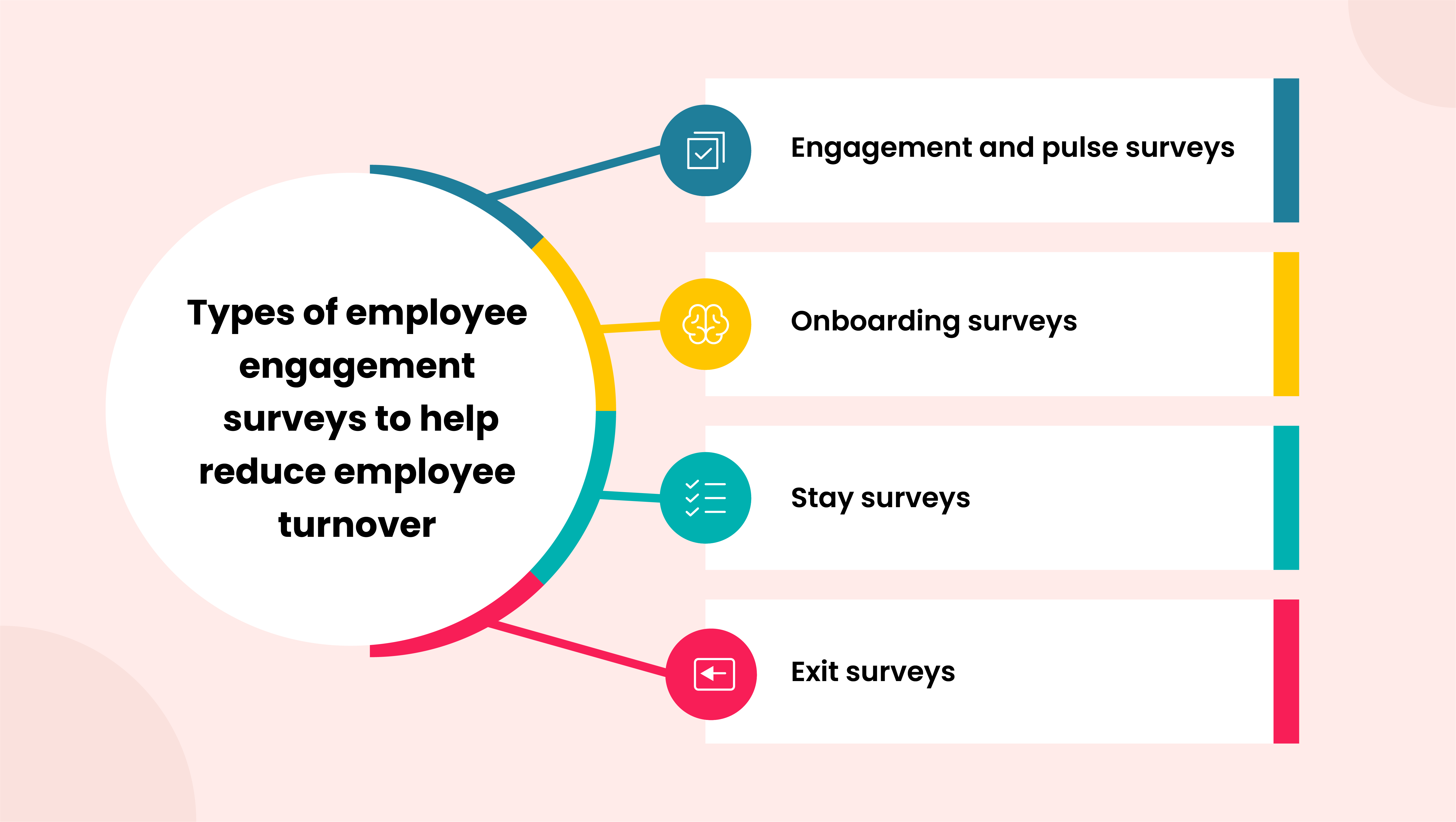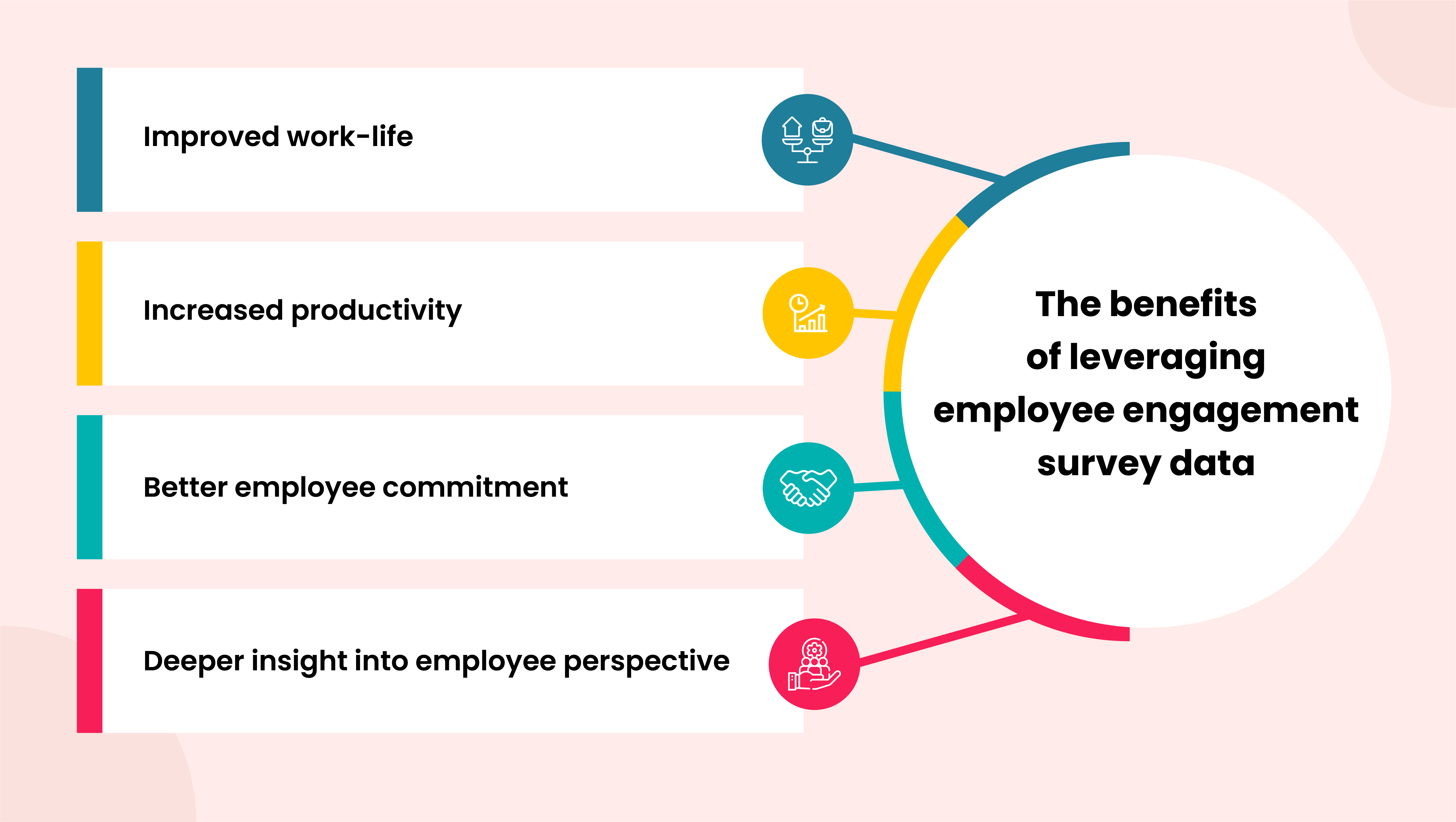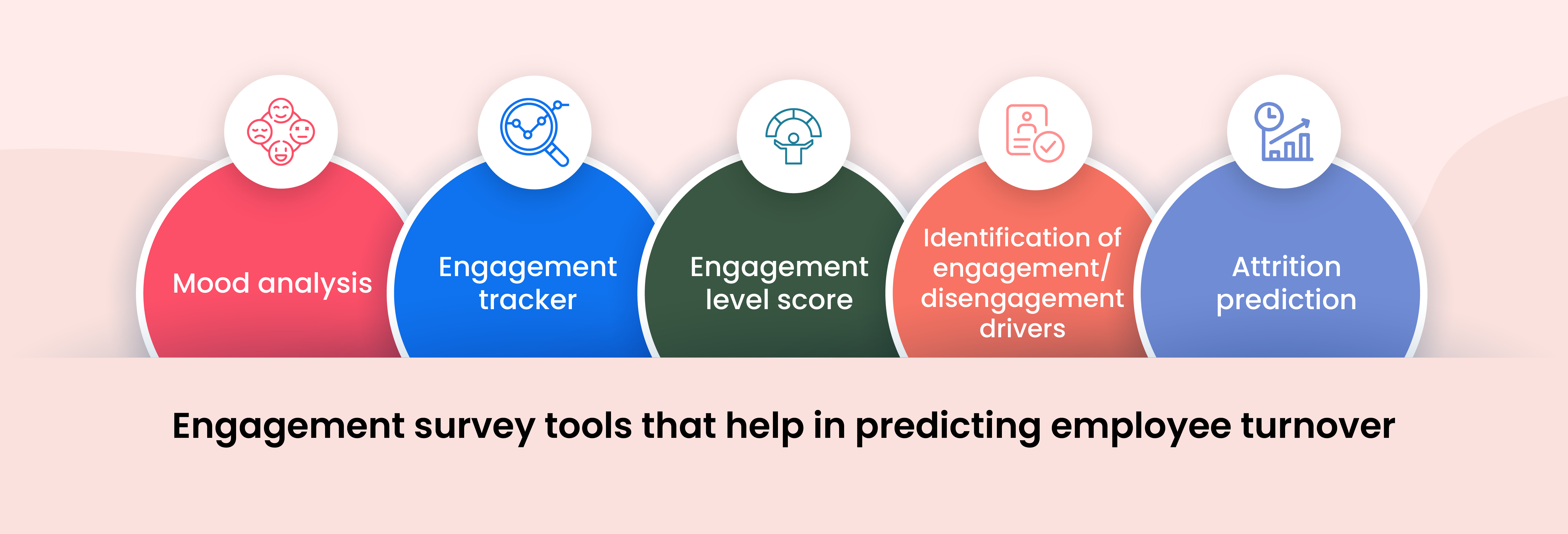Loyal and engaged employees are undeniably crucial for the success of any organization. As a result, retaining high-potential employees and reducing employee turnover is the top priority of every employer.
Recent studies suggest that it costs the business 6 to 9 months of salary on an average whenever an organization replaces its employee. Therefore, organizations are constantly looking for impactful solutions to prevent workplace attrition.
A demotivated workforce is one of the top reasons for the increased turnover rate. But with an effective engagement strategy in place, HR departments can reduce employee turnover by a significant margin.

One of the most effective ways to prevent workplace attrition is leveraging employee engagement survey data. The survey data acts as the holy grail that can clearly indicate the problematic areas in your existing engagement plans as well as single out the measures that are working in the favor of the organization.
Learn how to make the most of your employee engagement survey data to reduce workplace attrition, keep scrolling and reading.
The blog will also touch upon the definition of attrition in the workplace and how to reduce attrition in the workplace.
According to a report by the Corporate Leadership Council, engaged employees are 20% more productive and 87% less likely to job hop.
What are the leading causes of workplace attrition?

High attrition rates can cause considerable harm to a business by increasing hiring expenses, occupying recruiters’ time, and discouraging other employees. Hence, before addressing the problem of attrition in the workplace, it is important to understand the cause(s) behind it.
Let us look at some of the significant causes of workplace attrition:
Poor compensation
Compensation is one of the main reasons that derives an employee’s motivation to work. A well-paid employee knows that their skills and potential are adequately valued by their organization. However, in an opposite scenario, an under-paid employee will constantly look for better opportunities while maintaining a barely-engaged attitude towards their existing role.
In this post-pandemic work culture where employees are constantly revisiting their career choices, a low-compensation can only provoke your employees to make “the switch”.
Consequently, it becomes crucial for HRs to learn how satisfied their employees are with their current compensations, quarterly performance bonuses and annual appraisals. Diving into such feedback data can easily predict employees who might take up a better compensation package as soon as they are able to land one.
Overworking
Burnout caused by unmanageable work pressure is a significant factor driving people to seek new employment. An organization with an overworked workforce also has a high employee turnover rate.
There is little doubt that a heavy workload contributes to job discontent. Consistent overwork will cause your employees to associate the workplace with stress. Another cause of staff burnout is demanding work without offering appropriate resources.
Forbes reports that 46% of HR leaders have claimed that employee burnout accounts for 20% to 50% of yearly workplace turnover. Frequent employee feedback on their work pressure can be quite effective in preventing this. It will equip management and HR with accurate information and enable them to create a healthy work schedule.
Poor work-life balance
Work-life balance is an integral component of employee work satisfaction. Simply expressed, a healthy work-life balance refers to a comfortable balance between an employee’s professional and personal responsibilities.
If your employees cannot prioritize their personal lives, they become prone to absenteeism and lack of morale. An uninspired and drained employee will likely look for better job roles with flexible schedules.
Measures like a hybrid work model, flexible working hours, remote working, Etc. can assist them in balancing their professional and private life. This contributes to a better employee experience and increases employee retention.
Poor management
Poor management is another major contributing factor to growing attrition rates.
A 2020 report by Work Institute stated that 70% of employee attrition was preventable, and 7.8% of them were caused by incompetent management. Another study by the University of California journal revealed that 87% of them are less likely to quit their job.
An untrained manager is unable to recognize the unique talents of individuals and, as a result, is frequently unable to optimize the resources for the best possible results under the direction of incompetent managers.
Hiring managers with a good attitude, a strong eye for individual skills, and the ability to motivate their staff will produce a highly engaged, productive team and improve employee retention rates.
Inconsistent feedback
Frequent and honest feedback is one of the keys to consistently improving employee engagement. Lack of feedback doesn’t encourage the employees to perform with enthusiasmThey start to suffer from a lack of guidance and gradually lose interest in their job roles.
All these factors result in boredom, lack of productivity, and thus increased workplace attrition. Employees start looking for jobs in other organizations where their contributions will be assessed, appreciated, constructively critiqued, and praised.
Frequent feedback lets your employees know that their work holds significant meaning to the company’s growth and is being noticed by the leadership. This way, they feel motivated to do better and stay in their current company.
How surveys can help measure and reduce employee turnover?

In a world where organizations are increasingly leaning towards remote or hybrid work models, engagement survey data is the critical tool to analyze and assess employee experience. It offers clear insight into how your employees perceive their work environment, highlights the aspects that are working well and those that need improvement.
But boosting engagement does not happen overnight. As every industry and workforce is different, employee engagement strategies must be customized.
Employee surveys contain questions related to the specific workforce and provide insight into the employee’s perception of the work environment.
A successful employee survey identifies the defining moments of an employee’s experience. It measures the employees’ current situation and assesses their future professional plans. Such measurements give you insight into whether they want to build a career in your organization. It will also give you an idea of how to strategize your future hiring needs and which employees pose the risk of quitting their jobs.
Proper engagement surveys boost engagement, uncover skill gaps, and reduce employee absenteeism. Employee surveys help HR to deliver a work culture and experience that align with the company’s values and support the employees to do their best.
Leadership can hear the direct opinions of the workforce, take action, and ultimately improve the employee experience. In turn, employees see the organization’s effort, feel valued, experience the new changes being implemented, and hence, are less likely to look for better jobs in other companies.
To put it simply, elaborate engagement surveys and pulse surveys should be frequent and ideally be conducted throughout the year. It gives HR real-time metrics on employee experience and actionable insights on how to improve it.
What are the types of engagement surveys that help reduce employee turnover?

Engagement surveys data serve as the holy grail for valuable insights into what factors are most important to your employees. Organizations can use this information to create employee retention strategies that will help improve retention rates. Let’s have a look at the different types of employee engagement surveys that can help you gain insight into employee sentiments.
Engagement and pulse survey
Engagement surveys assess employees’ perceptions of all aspects of the organization. These surveys include questions asking employees’ opinions on different HR initiatives on employee engagement. Pulse surveys are brief and thus can be conducted frequently.
The HR department can acquire real-time insight into employee dissatisfaction and work on those to provide a better experience to the employees. Such surveys also assess employees’ perspective on recent organizational changes, productivity, work culture and their clarity on a company’s mission.
Onboarding surveys
A smooth onboarding is essential for overall employee satisfaction. That’s why HR departments conduct onboarding surveys after every recruitment cycle. An onboarding survey acts as the feedback strategy on the effectiveness of your company’s hiring process. It gives the HR department a chance to peek into the onboarding experience for new hires.
Stay surveys
These are a set of questionnaires that measure how likely the current employees are to continue their careers within an organization. It collects employees’ feelings about their job roles, career paths, and overall perception of the company. It tells you what areas to improve for better retention and lets you take quick action to prevent attrition in workplace.
Exit surveys
Exit surveys gather feedback on what drove the employees to leave the organizations. The exit surveys contain questions on the reason for departure, frustrations, work environment, compensations, and the perception of management.
Exit surveys are effective because employees feel more comfortable being honest when they leave the organization. Feedback without inhibitions gives HR a chance to improve those areas and reduce employee turnover.
What are the benefits of analyzing engagement survey data?

Asking the right questions and then taking action based on the feedback shows your employees that their opinion matters. Not only does It makes them feel valued, but it also gives you a chance to address their issues. Interactive engagement surveys help reduce turnovers in several ways.
Let us take a look at some of them that can help prevent attrition in workplace:
Improved work-life
Successful engagement surveys reveal the areas of work-life your employees enjoy. It is essential to structure interactive questions and give your employees the confidence to express their honest opinions.
This will let you take actions for improvements and enhance the employee experience. With a prompt resolution of their issues, your employees look forward to their workday and intend to make a career with your company.
Increased productivity
Employee engagement surveys facilitate the collection of valuable data that supports future engagement strategies. Employees feel heard and more invested in the organization each time an updated and upgraded engagement plan is developed based on employee feedback data. Thus, a significant improvement in employee engagement and productivity levels can be achieved.
A motivated and productive employee is more likely to stay with their current organization.
Better employee commitment
Engagement survey data or employee feedback data clearly indicate where the HR staff must concentrate its efforts to promote employee engagement. For instance, if employee feedback data suggests that a particular team does not feel heard by their boss and is consequently demotivated at work, the HR team may immediately address the issue by taking the necessary actions. These data-driven activities demonstrate to employees that their input is taken seriously. Consequently, resulting in a heightened level of commitment.
Deeper insight into employee perspective
Efficient and real-time surveys make employee retention significantly easier by informing you about unhappy employees and which areas are causing dissatisfaction.
Varied employee perspectives allow you to bridge the gaps and make the majority of your employees satisfied in your organization. You also have a better understanding of the efforts it takes to keep employees happy and decrease turnover.
How intelligent employee engagement surveys reduce employee turnover?

Now that you know what attrition is and how to reduce it in the workplace, let’s take a look at some of the benefits you can expect:
Attrition prediction
Analyzing employees’ plans and career goals provides an insight if they align with your company’s vision and mission. It also provides a real-time insight into how satisfied they are with their jobs. This way, you can predict how many employees are prone to changing careers.
Mood analysis
When combined with employee surveys, intelligent analytics technology supported by natural language processing and machine learning facilitates the interpretation of employee opinions. By evaluating how employees communicate within the workplace, AI-based surveys delve deeply into the mindsets and thoughts of employees. By closely observing their language, tone, and interests in contact via email and other channels, sentiment analysis can determine whether they are satisfied or unsatisfied with their work in a company. With such information, you can tailor employee engagement methods to each employee. It will precisely target the essential aspects of a given employee’s concerns.
Engagement level score
Cutting-edge survey analytics will track progress and constantly show engagement levels of employees. This gives you a tangible image of how good your engagement surveys are and how much progress you are making.
Track engagement
An employee engagement plan with analytics enables you to track your progress with follow-up pulse surveys. This further helps you identify the gaps and bridge them with suitable measures.
Identify engagement/disengagement drivers
As surveys ask pointed questions, analyzing the feedback helps you identify the exact drivers of employee engagement and which aspects negatively impact it. Taking suitable measures is only possible when you know which engagement drivers to target.
Leena AI’s employee engagement solutions to address workplace attrition

Finding the right employees requires a lot of resources. So, companies aim to reduce employee turnover as much as possible.
While employee engagement surveys give you actionable insights on the areas of improvement, it becomes a hectic job for HR to conduct them manually and frequently. Analyzing the large set of acquired data also becomes a mammoth task without the right automated analytics.
With Leena AI‘s advanced and automated employee engagement solution, you can discover real-time actionable insights through AI-powered engagement surveys. The cutting-edge intuitive software analyzes employee sentiment through feedback and provides personalized engagement plans.
It helps conduct frequent pulse surveys and allows you to take quick actions to bridge the gaps. The questions are engaging and conversational and help increase the participation rate. The open-ended employee feedback also predicts which employees may increase workplace attrition rate and gives you enough time to prevent it.
Opting for Leena AI will let you conduct surveys through simple and effective questionnaires and maintain consistent improvement in your engagement plan and reduce employee turnover.
Explore Leena AI's intelligent employee engagement solutions
Schedule a demo todayFrequently Asked Questions
What is attrition in employment?
Attrition in employment means the gradual reduction in the workforce resulting from retirement, resignation, or layoffs. Attrition has apparent disadvantages: your staff shrinks, you lose critical product/domain knowledge, and you risk harming your brand.
How to reduce attrition in the workplace?
Employee engagement plays a significant role in reducing workplace attrition. Engaged employees are more productive, appreciated, and well-compensated for their efforts. Periodic increments, consistent feedback, and opportunities for career growth helps enterprises reduce the employee turnover rate.
What does attrition mean in the workplace?
Attrition is when employees depart the workforce without being replaced, such as by resignation for personal reasons or retirement. In addition to the lack of professional advancement, unpleasant work environment, and waning trust in the company’s market value, there are additional causes of attrition. Weak leadership is another element that typically increases attrition among employees.






